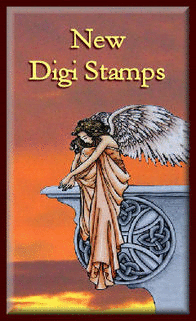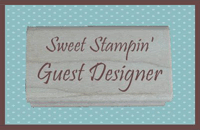The latest
Copic Creations challenge (
here) is to use paper that's not normally used when filling images with
Copic markers. Whew! This one
is tough. When I started using
Copics, I experimented with different types of paper and learned which papers to avoid. Now I've got to use 'em.
Hmmmm.
Stampavie is the sponsor of this challenge. Their stamp artists provide an assortment of very cutesy images of children and animals and some funny older women too. Their images can be appropriate for many different occasions and almost any sentiment can be used with them. I happen to have a
Stampavie image that I can use for this challenge.

Here's a pic of my first attempt using "other" paper. I used Memento Tuxedo Black ink to stamp a
Stampavie Sarah Kay Puppy Love stamp onto
Prima Sasha Paper Collection
patterned paper. The patterned paper has a printed distressed mix of light blues and greens throughout. Most of the stamp image areas are very tight and the paper is very thin and absorbed the ink quickly so I was always aware of the danger of spoiling my image with feathering ink. I like how the
Copic colors acted over the patterned paper, especially in the very light skin tone areas. The paper held up nicely too without warping or
pilling. (Click on the pics for a larger view.)
(RV000, RV34, Y17, Y28, BG10, BG23, E00, E35, R20, 0.)
I stamped the same image with the same ink onto The Paper Company Parchment Ivory
Cardstock. The
parchment paper acted more like watercolor paper as it took a lot of ink to get very little blend. I worked very carefully around the lines of my image to avoid feathering. I think the image looks nice but I definitely couldn't work with
Copics on this parchment paper in the way that these markers were made to apply color.
(B23, B32, Y17, Y28, RV000, RV34, E00, E35, R20, 0.)
This pic shows a C.C.Designs Swiss Pixies Birgitta image stamped with Memento Tuxedo Black ink onto a piece of cut
manila file folder. I found the same results as that from patterned paper and parchment paper. The manila file folder absorbed the marker color quickly and I had to work with the constant threat of color spilling outside of the lines of my image no matter how light-
handedly I applied my color. (As I post this pic, I realize that my sunflower has green petals - huh?!?!? - well, to justify it I guess I can add that Birgitta is a pixie, after all, and pixies can carry whatever they want, right? Now it's official, and it's in Rosie's Book, so it must be true -
LOL!!!)
(RV000, B23, B32, B00, Y15, Y17, YG00, YG23, E00, E35, 0.)
I tried to fill this image of Birgitta, using the same colors as the card above. This image was stamped on
Prima Sasha Collection green mixed flourished
patterned paper. (Yes, she's still carrying a sunflower with green petals -
LOL.) I like the way the
Copic colors act on the colored patterned paper as you can still get the effect even though the background color causes the marker color to take on a different look.
I tried a few different kinds of papers for this challenge. Generally I'm happy with the results. I found that I can control the color best by using a very light-handed 2-Tone Blending and avoid having the marker colors feather outside of the lines of my images. These "other" papers do have some very interesting looks, but if I want to show use of 3-Tone Smooth Blending then I'll turn to my
Neenah Classic Crest Solar White or
Bazzill Smooth White.
Which "other" papers have you tried to use your
Copic markers on?

 Some of the papers are die-cut . . .
Some of the papers are die-cut . . .















.jpg)
.jpg)






































































































